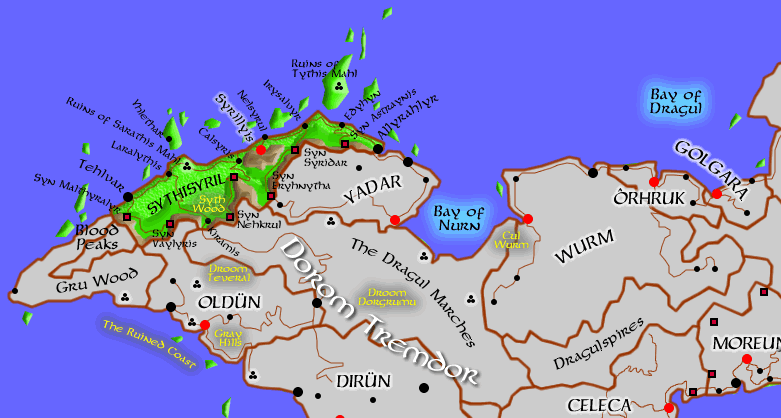The Twilight Kingdom
The Nehkrùli bastion in Vulmùra is the Kingdom of Syðìsyril. This long sieged state was founded in the early Second Age and has remained a poisonous thorn in the side of Dwürden-kind ever since. One of the five Night Eylfāe kingdoms of Teréth End, the people of Syðìsyril maintain close relations with the neighboring Nehkrul Kingdom of Arynzàlvya in Ardùwū.The Kingdom of Syðìsyril is renowned for its navy and was instrumental in moving Eylfāe and Yrūn during the Second Acèntyra-Dekàli War. Syðìsyrili ships have engaged in sea warfare in every Sea of the World of Teréth End and are sometimes employed to escort precious cargoes (or persons). In addition to military ships, the merchant vessels of Syðìsyril are known throughout the world. These ships are eagerly welcomed in most ports for their reputation of carrying exotic goods from the far reaches of the Five Lands.
Government
- Type – Nehkrùli Monarchy
- Ruler – Queen Ilmàrydānya the First
- Capital – City of Syríllyis
- Cities – Syríllyis (32,510), Allyrahlyr (20,670), Tehlvar (18,500), Edyhyn (11,620), Calsyris (10,050)
- Calendar – …
- Festivals – …
People
- Population – Syðìsyrilyr (650 DR) Unknown
- Races – Eylfāe 93%, Gnor 3%, Feyri 1%, other 3%
- Ethnicities –
- Languages – Niragôl
- Religions –
Trade
- Currency –
- Imports – Cheese, livestock, textiles
- Exports – Mythrul, precious stones, timber, wine
Regions, Geographic
- Syth Wood
Regions, Political
Cities, Towns, and Villages
- City of Syríllyis
- City of Allyrahlyr. Walled city on north coast.
- City of Tehlvar
- Town of Calsyris
- Town of Edyhyn
- Town of Irysalvyr
- Town of Kirámis. Walled town.
- Town of Larályðis
- Town of Nelsyrul
- Town of Yhléðar
Landmarks
- Ruins of Saráðis Mahl
- Ruins of Tȳðis Mahl
- Syn Astràynis
- Syn Eryhnytha
- Syn Malthyralyr
- Syn Nehkrul
- Syn Syrídar
- Syn Vaylyris
People
History
Syðìsyril is isolated from the remainder of Vulmùra by four neighbors: the Grū Wood (wilderness), Oldün (Dwürden), the Dragul Marches (Dragul, and Yādar (Yrūn). The unconquered Grū Wood would seem to be the least problematic for the Eylfāe kingdom, but it is not. At an early time, the Grū Wood and the Syth Wood were part of the same forest. When the Nehkrul first came to western Vulmùra they did their best to establish a defensible region and drive out all manner of nuisances. It is believed that these ancient troubles were not destroyed, but rather pushed south into what was later dubbed the Grū Wood. To this day, Syn Màlðyralyr continues the fight against the denizens of that place.
The second neighboring region of the Twilight Kingdom is the Dwürden Kingdom of Oldün. Though the clamor of battle horns and ringing shields have long ago faded from the Doróm Tremdor and Ruined Coast, this remains one of many uneasy borders maintained by these two races. Despite centuries of armistice, the border keeps remain alert and prepared to launch devastating strikes against each other at a moment’s notice. Spies are caught and exchanged with some regularity, often returned following weeks of merciless torture. Some prisoners have claimed that despite their unspeakable torment, no questions were ever asked. Here then is the state of affairs between these kingdoms, unchanged for generations.
The third neighboring region of Syðìsyril is another wilderness. The unwelcoming mountains of the Dragul Marches are home to the largest known concentration of Dragul in the World of Teréth End. From high remote lairs within the mountaintops of the Doróm Tremdor, Northern Dragul sleep and dream of Awakened flesh. Though the Dragul do not typically bother the residents of Syðìsyril, the Eylfāe prefer to watch the beasts and those that dare cross the realm from Oldün and the Bay of Nurn. In recent history (ca. 700 years ago), the Nehkrul Neylfèrahl sent two expeditions into the region with the aid of Wurmish hunters. Each expedition sought out an empty Dragul lair where they prepared an ambush for the returning beasts. Dwürdèni spies later learned that this experiment was a war game, aimed at testing Eylfāri tactics for use in the upcoming Second Acèntyri-Dekàli War. While the Northern Dragul have never been comparable to their Western kindred, the exercises may have given them valuable insight for conducting physical battle against the beasts. The Yrūn of Wurm only cared that there would be two less Dragul.
The last region to share a border with the Kingdom of Syðìsyril is the Yrūni Kingdom of Yādar. Initially, the Twilight Kingdom and the people of Yādar lived on friendly terms. When the stone-age Yrūn settled in the region late in the Third Age, the Eylfāe helped them adjust to the cold winters and taught them skills they would need to survive year round. Within a span of two hundred years the Yādàri emerged as a bronze-age people. Yādar flourished as an oasis of Mortal culture within the Winterlands. Soon, reports began filtering into Syríllyis regarding Yrūni uprisings in other Lands, and it was decided that the Mortals could not be trusted. In 3/2820 ER, the Twilight Kingdom invaded Yādar and slaughtered its unsuspecting residents. Despite widespread destruction, the campaign was only a partial success. The survivors of Yādar, with considerable help from Oldün, began rebuilding. Soon there were keeps appearing along the once peaceful border of Syðìsyríl. Within a generation the Yrūn began testing the Eylfāri defenses, at one point marching through the gates of Allyrahylyr (which was subsequently walled). When the Nehkrul attempted a Second Syðìsyríli-Yādàri War in 3/2848 ER, they were repelled by a Dwürdèni-Yrūni alliance.
Time Line
First Syðìsyríli-Yādàri War
- -2005 YW, 3/2820 ER; Syðìsyril attacks Yādar
Second Syðìsyríli-Yādàri War, 2848 ER
- -1977 YW, 3/2848 ER; Syðìsyril attacks Yādar but is repelled by Yrūni-Dwürdèni alliance
Dynasties
Nomenclature: Sythisyril Dekàlic: Syðìsyril (place), Syðìsyríli (pertaining to), Syðìsyrílyn (resident), Syðìsyrílyr
